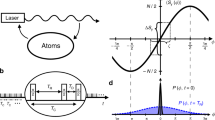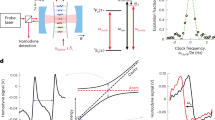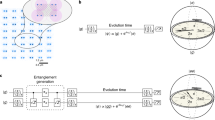Abstract
Neutral-atom arrays trapped in optical potentials are a powerful platform for studying quantum physics, combining precise single-particle control and detection with a range of tunable entangling interactions1,2,3. For example, these capabilities have been leveraged for state-of-the-art frequency metrology4,5 as well as microscopic studies of entangled many-particle states6,7,8,9,10,11. Here we combine these applications to realize spin squeezing—a widely studied operation for producing metrologically useful entanglement—in an optical atomic clock based on a programmable array of interacting optical qubits. In this demonstration of Rydberg-mediated squeezing with a neutral-atom optical clock, we generate states that have almost four decibels of metrological gain. In addition, we perform a synchronous frequency comparison between independent squeezed states and observe a fractional-frequency stability of 1.087(1) × 10−15 at one-second averaging time, which is 1.94(1) decibels below the standard quantum limit and reaches a fractional precision at the 10−17 level during a half-hour measurement. We further leverage the programmable control afforded by optical tweezer arrays to apply local phase shifts to explore spin squeezing in measurements that operate beyond the relative coherence time with the optical local oscillator. The realization of this spin-squeezing protocol in a programmable atom-array clock will enable a wide range of quantum-information-inspired techniques for optimal phase estimation and Heisenberg-limited optical atomic clocks12,13,14,15,16.
This is a preview of subscription content, access via your institution
Access options
Access Nature and 54 other Nature Portfolio journals
Get Nature+, our best-value online-access subscription
$29.99 / 30 days
cancel any time
Subscribe to this journal
Receive 51 print issues and online access
$199.00 per year
only $3.90 per issue
Buy this article
- Purchase on Springer Link
- Instant access to full article PDF
Prices may be subject to local taxes which are calculated during checkout




Similar content being viewed by others
Data availability
The experimental data presented in this article are available from the corresponding author upon reasonable request. Source data are provided with this paper.
Code availability
The code used for analysis and simulation in this work is available from the corresponding author upon reasonable request.
References
Schleier-Smith, M. H., Leroux, I. D. & Vuletić, V. States of an ensemble of two-level atoms with reduced quantum uncertainty. Phys. Rev. Lett. 104, 073604 (2010).
Gross, C. & Bloch, I. Quantum simulations with ultracold atoms in optical lattices. Science 357, 995–1001 (2017).
Browaeys, A. & Lahaye, T. Many-body physics with individually controlled Rydberg atoms. Nat. Phys. 16, 132–142 (2020).
Young, A. W. et al. Half-minute-scale atomic coherence and high relative stability in a tweezer clock. Nature 588, 408–413 (2020).
Madjarov, I. S. et al. An atomic-array optical clock with single-atom readout. Phys. Rev. X 9, 041052 (2019).
Fukuhara, T. et al. Spatially resolved detection of a spin-entanglement wave in a Bose–Hubbard chain. Phys. Rev. Lett. 115, 035302 (2015).
Islam, R. et al. Measuring entanglement entropy in a quantum many-body system. Nature 528, 77–83 (2015).
Kaufman, A. M. et al. Quantum thermalization through entanglement in an isolated many-body system. Science 353, 794–800 (2016).
Graham, T. et al. Multi-qubit entanglement and algorithms on a neutral-atom quantum computer. Nature 604, 457–462 (2022).
Bluvstein, D. et al. A quantum processor based on coherent transport of entangled atom arrays. Nature 604, 451–456 (2022).
Zhang, W.-Y. et al. Functional building blocks for scalable multipartite entanglement in optical lattices. Preprint at https://arxiv.org/abs/2210.02936 (2022).
Tóth, G. & Apellaniz, I. Quantum metrology from a quantum information science perspective. J. Phys. A 47, 424006 (2014).
Kaubruegger, R. et al. Variational spin-squeezing algorithms on programmable quantum sensors. Phys. Rev. Lett. 123, 260505 (2019).
Kaubruegger, R., Vasilyev, D. V., Schulte, M., Hammerer, K. & Zoller, P. Quantum variational optimization of Ramsey interferometry and atomic clocks. Phys. Rev. X 11, 041045 (2021).
Kessler, E. M. et al. Heisenberg-limited atom clocks based on entangled qubits. Phys. Rev. Lett. 112, 190403 (2014).
Pezzè, L. & Smerzi, A. Heisenberg-limited noisy atomic clock using a hybrid coherent and squeezed state protocol. Phys. Rev. Lett. 125, 210503 (2020).
Pezzè, L., Smerzi, A., Oberthaler, M. K., Schmied, R. & Treutlein, P. Quantum metrology with nonclassical states of atomic ensembles. Rev. Mod. Phys. 90, 035005 (2018).
Backes, K. M. et al. A quantum enhanced search for dark matter axions. Nature 590, 238–242 (2021).
Tse, M. et al. Quantum-enhanced Advanced LIGO detectors in the era of gravitational-wave astronomy. Phys. Rev. Lett. 123, 231107 (2019).
Ludlow, A. D., Boyd, M. M., Ye, J., Peik, E. & Schmidt, P. O. Optical atomic clocks. Rev. Mod. Phys. 87, 637–701 (2015).
Sanner, C. et al. Optical clock comparison for Lorentz symmetry testing. Nature 567, 204–208 (2019).
Kennedy, C. J. et al. Precision metrology meets cosmology: improved constraints on ultralight dark matter from atom-cavity frequency comparisons. Phys. Rev. Lett. 125, 201302 (2020).
Bothwell, T. et al. Resolving the gravitational redshift across a millimetre-scale atomic sample. Nature 602, 420–424 (2022).
Zheng, X., Dolde, J., Lim, H. M. & Kolkowitz, S. A lab-based test of the gravitational redshift with a miniature clock network. Preprint at https://arxiv.org/abs/2207.07145 (2022).
Greve, G. P., Luo, C., Wu, B. & Thompson, J. K. Entanglement-enhanced matter-wave interferometry in a high-finesse cavity. Nature 610, 472–477 (2022).
Braverman, B. et al. Near-unitary spin squeezing in 171Yb. Phys. Rev. Lett. 122, 223203 (2019).
Malia, B. K., Wu, Y., Martínez-Rincón, J. & Kasevich, M. A. Distributed quantum sensing with mode-entangled spin-squeezed atomic states. Nature 612, 661–665 (2022).
Pedrozo-Peñafiel, E. et al. Entanglement on an optical atomic-clock transition. Nature 588, 414–418 (2020).
Colombo, S. et al. Time-reversal-based quantum metrology with many-body entangled states. Nat. Phys. 18, 925–930 (2022).
Robinson, J. M. et al. Direct comparison of two spin squeezed optical clocks below the quantum projection noise limit. Preprint at https://arxiv.org/abs/2211.08621 (2022).
Bouchoule, I. & Mølmer, K. Spin squeezing of atoms by the dipole interaction in virtually excited Rydberg states. Phys. Rev. A 65, 041803 (2002).
Gil, L. I. R., Mukherjee, R., Bridge, E. M., Jones, M. P. A. & Pohl, T. Spin squeezing in a Rydberg lattice clock. Phys. Rev. Lett. 112, 103601 (2014).
Jau, Y.-Y., Hankin, A., Keating, T., Deutsch, I. H. & Biedermann, G. Entangling atomic spins with a Rydberg-dressed spin-flip blockade. Nat. Phys. 12, 71–74 (2016).
Borish, V., Marković, O., Hines, J. A., Rajagopal, S. V. & Schleier-Smith, M. Transverse-field Ising dynamics in a Rydberg-dressed atomic gas. Phys. Rev. Lett. 124, 063601 (2020).
Guardado-Sanchez, E. et al. Quench dynamics of a Fermi gas with strong nonlocal interactions. Phys. Rev. X 11, 021036 (2021).
Zeiher, J. et al. Coherent many-body spin dynamics in a long-range interacting Ising chain. Phys. Rev. X 7, 041063 (2017).
Van Damme, J., Zheng, X., Saffman, M., Vavilov, M. G. & Kolkowitz, S. Impacts of random filling on spin squeezing via Rydberg dressing in optical clocks. Phys. Rev. A 103, 023106 (2021).
Friis, N., Vitagliano, G., Malik, M. & Huber, M. Entanglement certification from theory to experiment. Nat. Rev. Phys. 1, 72–87 (2019).
Wineland, D. J., Bollinger, J. J., Itano, W. M., Moore, F. L. & Heinzen, D. J. Spin squeezing and reduced quantum noise in spectroscopy. Phys. Rev. A 46, R6797–R6800 (1992).
Zheng, X. et al. Differential clock comparisons with a multiplexed optical lattice clock. Nature 602, 425–430 (2022).
Marti, G. E. et al. Imaging optical frequencies with 100μHz precision and 1.1μm resolution. Phys. Rev. Lett. 120, 103201 (2018).
Young, A. W., Eckner, W. J., Schine, N., Childs, A. M. & Kaufman, A. M. Tweezer-programmable 2D quantum walks in a Hubbard-regime lattice. Science 377, 885–889 (2022).
Stockton, J. K., Wu, X. & Kasevich, M. A. Bayesian estimation of differential interferometer phase. Phys. Rev. A 76, 033613 (2007).
Schine, N., Young, A. W., Eckner, W. J., Martin, M. J. & Kaufman, A. M. Long-lived Bell states in an array of optical clock qubits. Nat. Phys. 18, 1067–1073 (2022).
McGrew, W. F. et al. Atomic clock performance enabling geodesy below the centimetre level. Nature 564, 87–90 (2018).
Henkel, N., Nath, R. & Pohl, T. Three-dimensional roton excitations and supersolid formation in Rydberg-excited Bose–Einstein condensates. Phys. Rev. Lett. 104, 195302 (2010).
Kitagawa, M. & Ueda, M. Squeezed spin states. Phys. Rev. A 47, 5138–5143 (1993).
Young, J. T., Muleady, S. R., Perlin, M. A., Kaufman, A. M. & Rey, A. M. Enhancing spin squeezing using soft-core interactions. Phys. Rev. Res. 5, L012033 (2023).
Block, M. et al. A universal theory of spin squeezing. Preprint at https://arxiv.org/abs/2301.09636 (2023).
Geier, S. et al. Floquet Hamiltonian engineering of an isolated many-body spin system. Science 374, 1149–1152 (2021).
Marciniak, C. D. et al. Optimal metrology with programmable quantum sensors. Nature 603, 604–609 (2022).
Bowden, W., Vianello, A., Hill, I. R., Schioppo, M. & Hobson, R. Improving the Q factor of an optical atomic clock using quantum nondemolition measurement. Phys. Rev. X 10, 041052 (2020).
Bornet, G. et al. Scalable spin squeezing in a dipolar Rydberg atom array. Preprint at https://arxiv.org/abs/2303.08053 (2023).
Franke, J. et al. Quantum-enhanced sensing on an optical transition via emergent collective quantum correlations. Preprint at https://arxiv.org/abs/2303.10688 (2023).
Norcia, M. A., Young, A. W. & Kaufman, A. M. Microscopic control and detection of ultracold strontium in optical-tweezer arrays. Phys. Rev. X 8, 041054 (2018).
Kumar, A., Wu, T.-Y., Giraldo, F. & Weiss, D. S. Sorting ultracold atoms in a three-dimensional optical lattice in a realization of Maxwell’s demon. Nature 561, 83–87 (2018).
Endres, M. et al. Atom-by-atom assembly of defect-free one-dimensional cold atom arrays. Science 354, 1024–1027 (2016).
Barredo, D., De Léséleuc, S., Lienhard, V., Lahaye, T. & Browaeys, A. An atom-by-atom assembler of defect-free arbitrary two-dimensional atomic arrays. Science 354, 1021–1023 (2016).
Young, A. W. et al. An atomic boson sampler. Preprint at https://arxiv.org/abs/2307.06936 (2023).
Taichenachev, A. V. et al. Magnetic field-induced spectroscopy of forbidden optical transitions with application to lattice-based optical atomic clocks. Phys. Rev. Lett. 96, 083001 (2006).
Matei, D. G. et al. 1.5 μm lasers with sub-10 mHz linewidth. Phys. Rev. Lett. 118, 263202 (2017).
Oelker, E. et al. Demonstration of 4.8 × 10−17 stability at 1 s for two independent optical clocks. Nat. Photon. 13, 714–719 (2019).
Carpenter, J. & Bithell, J. Bootstrap confidence intervals: when, which, what? A practical guide for medical statisticians. Stat. Med. 19, 1141–1164 (2000).
Efron, B. & Stein, C. The jackknife estimate of variance. Ann. Stat. 9, 586–596 (1981).
van den Worm, M., Sawyer, B. C., Bollinger, J. J. & Kastner, M. Relaxation timescales and decay of correlations in a long-range interacting quantum simulator. New J. Phys. 15, 083007 (2013).
Acknowledgements
We acknowledge earlier contributions to the experiment from M. A. Norcia and N. Schine and discussions with S. Geller, R. B. Hutson, W. F. McGrew, S. R. Muleady, A. M. Rey, N. Schine, M. Schleier-Smith, J. K. Thompson, J. T. Young and P. Zoller. We thank S. Geller, S. R. Muleady, J. K. Thompson and P. Zoller for reading the paper and comments; and A. Aeppli, D. Kedar, K. Kim, B. Lewis, M. Miklos, Y. M. Tso, W. Warfield, L. Yan and Z. Yao for discussions and contributions to the clock laser system. This material is based on work supported by the Army Research Office (W911NF-19-1-0149 and W911NF-19-1-0223), Air Force Office for Scientific Research (FA9550-19-1-0275), National Science Foundation QLCI (OMA-2016244), US Department of Energy, Office of Science, National Quantum Information Science Research Centers, Quantum Systems Accelerator, and the National Institute of Standards and Technology. We also acknowledge funding from Lockheed Martin. W.J.E. acknowledges support from the NDSEG Fellowship; N.D.O. acknowledges support from the Alexander von Humboldt Foundation; and A.C. acknowledges support from the NSF Graduate Research Fellowship Program (grant number DGE2040434).
Author information
Authors and Affiliations
Contributions
W.J.E., N.D.O., A.C., A.W.Y. and A.M.K. built and operated the optical lattice and tweezer apparatus. The silicon-crystal stabilized clock laser was operated by W.R.M., J.M.R. and J.Y. All authors contributed to data analysis and development of the paper.
Corresponding author
Ethics declarations
Competing interests
The authors declare no competing interests.
Peer review
Peer review information
Nature thanks Sebastian C. Carrasco, Michael Goerz and the other, anonymous, reviewer(s) for their contribution to the peer review of this work. Peer reviewer reports are available.
Additional information
Publisher’s note Springer Nature remains neutral with regard to jurisdictional claims in published maps and institutional affiliations.
Supplementary information
Rights and permissions
About this article
Cite this article
Eckner, W.J., Darkwah Oppong, N., Cao, A. et al. Realizing spin squeezing with Rydberg interactions in an optical clock. Nature 621, 734–739 (2023). https://doi.org/10.1038/s41586-023-06360-6
Received:
Accepted:
Published:
Issue Date:
DOI: https://doi.org/10.1038/s41586-023-06360-6
This article is cited by
Comments
By submitting a comment you agree to abide by our Terms and Community Guidelines. If you find something abusive or that does not comply with our terms or guidelines please flag it as inappropriate.



